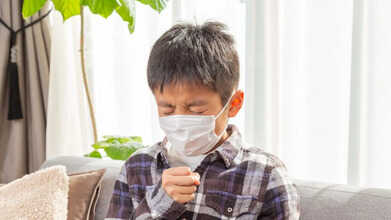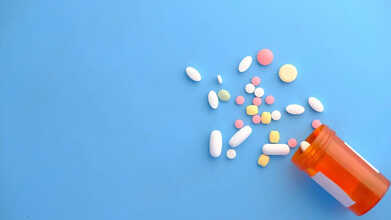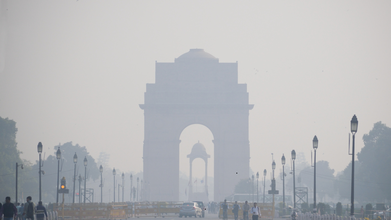- Health Conditions A-Z
- Health & Wellness
- Nutrition
- Fitness
- Health News
- Ayurveda
- Videos
- Medicine A-Z
- Parenting
Winter Skincare: Let’s Get Real About Skin Woes During Cold Weather- Debunking Myths

Winter Skincare: Let’s Get Real About Skin Woes During Cold Weather- Debunking Myths
Every winter, as temperatures drop and dry, chilly winds take over, the battle to keep skin smooth and hydrated becomes all too real. From dealing with unexpected patches of dryness to choosing the right products that actually work, winter skincare often feels like a puzzle. Even when we think we’re doing the best for our skin, common misconceptions can lead us astray.
Common Skincare Issues During Winters
Winter's cold and dry air can strip skin of its natural moisture, often leading to dryness, flakiness, and irritation. Sensitive skin may also become red or inflamed in colder months.
- Dryness: Low humidity and cold air pull moisture from the skin, causing dryness and tightness.
- Flakiness: Dead skin cells accumulate, resulting in a flaky, rough texture.
- Irritation: Sensitive skin becomes easily irritated and red, particularly in windy or cold conditions.
- Chapped Lips: Lips lack oil glands, making them prone to cracking and discomfort.
- Itchy Skin: Dry skin can trigger itching, particularly on exposed areas like hands and face.
Winter can be tough on your skin, but it’s easier to handle when you separate myths from facts. Rather than getting swept up in popular advice, focus on what your skin truly needs. Opt for a daily routine that includes gentle cleansing, sufficient moisturizing, and year-round sun protection. Understanding your skin type and choosing products that suit it can make all the difference, ensuring that your skin stays healthy, comfortable, and radiant, no matter how chilly the season gets.
Misconceptions About Winter Skincare
Here, we debunk some popular winter skincare myths to help you make informed choices and keep your skin glowing all season long.
Myth: Natural Skincare Products Are Always Better
Fact: The word “natural” on a skincare label can be misleading. While natural ingredients may seem gentle and safe, they’re not always better for your skin. In fact, certain natural components, like essential oils or fruit extracts, can cause irritation or allergic reactions, especially in sensitive skin. On the other hand, synthetic ingredients, developed in controlled environments, are often tested for safety and can be highly effective. The key is to choose products based on your skin’s specific needs, not just on whether they’re natural or synthetic.
Myth: Higher SPF Means Longer Sun Protection, and Sunscreen Isn’t Needed in Winter
Fact: SPF measures the level of protection against UVB rays, but it doesn’t indicate the length of time sunscreen protects your skin. Regardless of the SPF number, all sunscreens need to be reapplied every two hours to remain effective. Additionally, winter skies might look cloudy, but UV rays can penetrate through clouds, making sunscreen a year-round necessity. Remember, UVA rays, which cause premature aging, are always present, so protect your skin by wearing sunscreen every day—even in winter.
Myth: Oily Skin Doesn’t Need Moisturizer During Winter
Fact: Oily skin may feel less dry than other skin types, but that doesn’t mean it can skip moisturizer in winter. In fact, depriving oily skin of moisture can lead to increased oil production as the skin tries to compensate. To keep oily skin balanced, opt for a lightweight, oil-free moisturizer that hydrates without clogging pores. Look for ingredients like hyaluronic acid and glycerin, which attract moisture to the skin without adding extra oil.
Myth: Splashing Cold Water on Your Face Closes Pores
Fact: This age-old myth has led many to believe that a splash of cold water can shrink pores, but here’s the truth: pores do not have muscles, so they can’t open or close. Cold water may temporarily tighten the skin, giving a fleeting illusion of smaller pores, but it doesn’t actually change their size. For more effective pore care, use gentle exfoliators to clear out dirt and oil buildup, and consider products with niacinamide to improve the appearance of enlarged pores over time.
Myth: Petroleum Jelly Is the Ultimate Moisturizer
Fact: While petroleum jelly is often praised for its ability to lock in moisture, it doesn’t actively hydrate the skin. Instead, it forms a barrier that prevents water loss, which can be helpful as the final layer in your winter skincare routine. However, for deep hydration, look for moisturizers with ingredients like shea butter, ceramides, and fatty acids. These elements nourish the skin, strengthen its protective barrier, and combat the harsh effects of cold, dry weather, providing lasting comfort and moisture.
COVID Or Seasonal Flu: NHS Explains What Your Cough May Be Signalling

Credits: Canva
A particular type of cough could offer an important clue about whether you have Covid or flu this winter. The NHS has outlined how the two illnesses can be told apart.
Why Do Respiratory Illnesses Rise In Winter?
As winter arrives, a noticeable increase in seasonal illnesses is expected. Conditions such as the common cold, respiratory syncytial virus (RSV), COVID-19, and influenza tend to spread more easily during colder months. This happens because viruses thrive in lower temperatures and people spend longer periods indoors, often in close proximity to others.
Why Covid and Flu Can Be Hard To Tell Apart
Distinguishing between these infections is not always easy, as many symptoms overlap. According to guidance published by the NHS, the following symptoms are commonly seen in both Covid and flu:
- A high temperature
- A sore throat
- Feeling tired or extremely fatigued
- A headache
- Diarrhoea
- Feeling sick or vomiting
- Loss of appetite
- Coughing is another symptom shared by both conditions, though the nature of the cough can differ.
Cough
Flu and Covid are among the illnesses that become more common during the winter months. If you have influenza, the NHS explains that the cough is usually dry and may develop suddenly, often alongside other symptoms that appear quickly.
In contrast, Covid may cause what the NHS describes as a “new, continuous cough.” This refers to coughing frequently for more than an hour, or experiencing three or more coughing episodes within a 24-hour period.
This distinction is supported by Dr Rupa Parmar, a GP and medical director at Midland Health. In previous comments, she noted that coughs linked to colds are generally mild, while flu tends to cause a dry cough.
“With Covid, the cough is often dry and persistent,” she explained. “Many people cough continuously for long periods or have repeated coughing fits throughout the day.”
Ways To Differentiate Between Covid and Influenza
The type of cough is not the only sign that may help identify which illness you have. A reduced or altered sense of smell or taste is commonly reported in people with Covid and is much less frequent in flu cases.
Breathlessness is another symptom recognised by the NHS as being associated with Covid. While flu can sometimes lead to breathing difficulties, this usually occurs only if the illness becomes severe.
What to do if you have symptoms:
For both Covid and flu, the NHS advises staying at home and limiting contact with others if you or your child have symptoms and either:
- Have a high temperature
- Do not feel well enough to attend work, school, childcare, or carry out normal activities
- The guidance states that normal routines can be resumed once symptoms improve and the temperature returns to normal.
When to seek urgent medical advice:
The NHS recommends contacting your GP or NHS 111 urgently if:
- You are worried about Covid symptoms in yourself or your child and are unsure what to do
- Symptoms are worsening or not improving
- You or your child develop additional signs of illness, such as a rash, poor appetite, or weakness
- A high temperature lasts for five days or more, or does not come down after taking paracetamol
- A baby under three months has a temperature of 38C or above, or is suspected to have a fever
- A child aged three to six months has a temperature of 39C or above, or is suspected to have a fever
- You or your child have flu-like symptoms and you are over 65, pregnant, living with a long-term health condition, have a weakened immune system, or symptoms have not eased after seven days
Levothyroxine Thyroid Medicine: NHS Issues Urgent Warning For Patients

Credits: Canva
The NHS has released a warning for people who take levothyroxine to manage thyroid conditions. With an estimated 33 million prescriptions issued every year across the UK, levothyroxine is among the most frequently prescribed medicines provided by the NHS.
Levothyroxine is mainly used to treat an underactive thyroid, a condition medically known as hypothyroidism. Depending on a patient’s needs and a GP’s assessment, the medicine is usually prescribed either as a tablet or as a liquid taken by mouth.
What Is Levothyroxine?
For many patients, levothyroxine is effective in helping the body restore normal thyroid hormone levels. However, the NHS has stressed that the medication is not suitable for everyone. In certain cases, taking levothyroxine may raise the risk of complications linked to other existing health problems.The NHS website explains that while most adults and children can safely take levothyroxine, there are specific situations where it may not be recommended. These restrictions are based on a person’s medical history and current health conditions.
People Who May Not Be Able to Take Levothyroxine
According to NHS guidance, levothyroxine may not be suitable if any of the following apply:
- You have a heart condition such as angina, heart disease, or heart failure
- You have a condition that affects your adrenal glands
- You have previously suffered a heart attack
- You have an overactive thyroid that produces excess thyroid hormone, known as thyrotoxicosis
- You have diabetes
- You have had an allergic reaction to levothyroxine or another medicine in the past
- You have high blood pressure
- Patients are advised to inform their GP or specialist about any of these conditions before starting treatment.
Levothyroxine: Possible Side Effects to Be Aware Of
Levothyroxine can cause a range of side effects, some of which may require urgent medical attention. Common side effects associated with the medication include:
- Flushing or excessive sweating
- Feeling restless, anxious, or overly energetic
- Difficulty sleeping
- Nausea
- Headaches
- Vomiting
- Shaking or trembling
- Diarrhoea
- Muscle cramps
The NHS notes that this is not a complete list, and other side effects may occur. Patients are advised to read the information leaflet included with their medication for full details.
Levothyroxine: When to Seek Medical Help
Although these side effects can be unpleasant, they are usually mild and do not typically require a hospital visit. If symptoms persist or become troublesome, the NHS recommends speaking to a doctor or pharmacist for advice.
However, certain symptoms should not be ignored. If you notice a fast or irregular heartbeat while taking levothyroxine, you should contact a doctor or call NHS 111 as soon as possible.
More serious symptoms require immediate action. Anyone experiencing chest pain while on levothyroxine is advised to call 999 without delay, as this could signal a medical emergency.
Disclaimer: This article is for general information only and is not a substitute for medical advice. Levothyroxine should be taken only as prescribed by a qualified healthcare professional. Do not start, stop, or change your medication without consulting your doctor. If you experience severe symptoms or a medical emergency, seek immediate medical attention or call emergency services.
Delhi Will See Pollution-free Blue Sky In Next 3-4 Years, Says Authority

Credits: iStock
Delhi, on Wednesday morning, woke up to 'very poor' air. The visibility was low and, in fact, the India Meteorological Department (IMD) issued an orange alert for dense fog between 8.30am and 10am. Visibility remained low, and as per the 24-hour average Air Quality Index, Delhi stood at 384, as confirmed by the data from the Central Pollution Control Board (CPCB). In certain areas, including Anand Vihar, AQI remained under 'severe' level, at 452.
This has resulted in cancellation of t least 148 flights and over 150 flights were delayed at the Delhi airport.
However, there may be a silver lining, in an interview with TOI, Tarun Kumar Pithode, who took charge as the new full-time member secretary of the Commission for Air Quality Management (CAQM) said that Delhi can expect "more blue-sky days over next 3-4 years".
How Does The Commission for Air Quality Management Plan To Bring Delhi's Pollution Down?
Delhi’s fight against air pollution is set to intensify over the next few years, with the CAQM outlining a multi-pronged plan aimed at delivering “more blue-sky days” for the capital. Rather than relying on emergency measures alone, the strategy focuses on long-term, structural fixes across transport, industry, energy and regional coordination.
Cutting Emissions at the Source
One of CAQM’s core priorities is reducing pollution from vehicles, which remain a major contributor to Delhi’s poor air quality. The plan pushes for faster adoption of electric vehicles, tighter checks on polluting commercial vehicles, and a stronger public transport network. Scrapping old, high-emission vehicles and discouraging diesel use through stricter enforcement are seen as key steps to curb everyday emissions, not just during winter spikes.
Cleaning Up Industry and Power Generation
Industrial pollution is another major target. CAQM has stressed a shift away from coal and other dirty fuels toward cleaner energy sources. Industries operating in and around Delhi are being pushed to adopt cleaner fuels such as natural gas, along with better emission-control technologies. Power plants in the region are also under scrutiny, with stricter norms to ensure they do not become pollution hotspots during peak winter months.
Tackling Dust and Construction Pollution
Construction dust and road dust significantly worsen Delhi’s air quality, especially during dry months. CAQM’s plan includes stricter enforcement of dust-control norms at construction sites, better mechanised road sweeping, and regular water sprinkling on major roads. Authorities are also being asked to improve urban planning to reduce exposed soil and unpaved areas that contribute to dust pollution.
Managing Seasonal Pollution and Stubble Burning
A major part of Delhi’s pollution problem comes from outside the city, particularly crop residue burning in neighboring states. CAQM has emphasized regional coordination, working with states like Punjab, Haryana and Uttar Pradesh to reduce stubble burning. This includes promoting alternative methods for crop residue management, providing financial incentives, and ensuring accountability when violations occur.
Data-Driven and Year-Round Action
Unlike earlier approaches that focused largely on winter emergencies, CAQM’s plan relies on year-round monitoring and data-driven action. Expanded air-quality monitoring, better forecasting, and early interventions are expected to prevent pollution levels from spiralling out of control. The aim is to move from reactive crisis management to consistent prevention.
A Long Road Ahead
CAQM officials acknowledge that Delhi’s pollution problem will not disappear overnight. However, with coordinated action across sectors and states, they believe the capital can see steady improvement over the next three to four years. The promise of more blue-sky days hinges not just on policy, but on strict enforcement and sustained public cooperation.
© 2024 Bennett, Coleman & Company Limited

